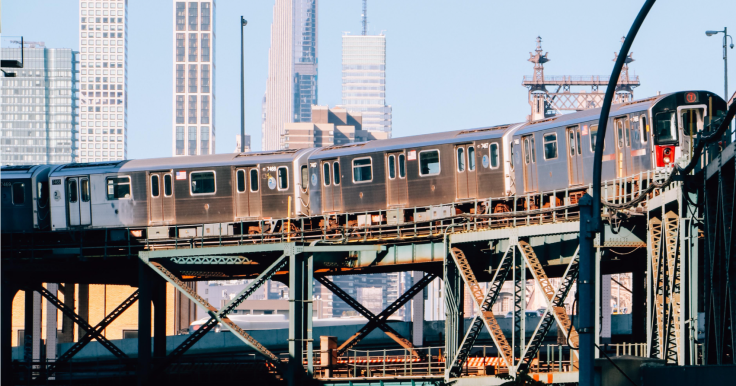Subway Surfer Videos Go Viral as Teens 12 and 13 Killed After Doing Dangerous TikTok Trend
Their deaths bring the total number of fatalities linked to subway surfing so far in 2025 to five.

On Saturday, the city of New York woke to heartbreaking news that two teenage girls, aged 12 and 13, were found dead on top of a subway car at the Marcy Avenue–Broadway station in Williamsburg, Brooklyn.
The incident, which authorities believe is linked to the rising practice of subway surfing, a risky trend glamorised on social media, has reignited warnings from transit officials, grief from families, and an anxious reckoning about how online challenges might be pushing children to lethal extremes.
Teens Who Lost Their Lives
According to reports, the younger victim, Zemfira Mukhtarov, hailed from Brooklyn and would have turned 13 just two weeks later, her father tearfully wrote in a GoFundMe memorial.
The second victim, Ebba Morina, lived in Manhattan. According to law enforcement sources, the pair were discovered around 3:10am in an unresponsive state atop a Brooklyn-bound J train and pronounced dead at the scene.
Their deaths bring the total number of fatalities linked to subway surfing so far in 2025 to five, continuing a troubling trend that has claimed multiple lives in recent years.
How the Tragedy Unfolded
Public accounts suggest that both girls were part of a larger group of about 15 teens running inside the train moments before they were found on the roof, witnesses told police. Days before, Zemfira had posted daring TikTok videos, one showing her lying on train tracks while a subway passed overhead, feeding speculation that she was drawn into the thrill-seeking culture of viral content.
9:39 AM EDT, Bronx, NY. R62A cars 2099 - 2100 had surfers today going Northbound. #MTA #NYC #staysafe #subway #Surfing pic.twitter.com/bZXuEv0Ydd
— Criss (@WeatherManCriss) February 7, 2024
Family statements add emotional weight to the report. Zemfira's father described her as 'full of life' and said no parent should face such a loss. Meanwhile, her younger sister, Maryam, now 11, identified Zemfira's skateboard and bag on a TV news segment, triggering the family's realisation of the tragedy.
Maryam told WABC that although Zemfira rarely talked openly about subway surfing, the risk was real. 'It's just not worth it,' she said.
Viral Videos Spark Outrage and Fear
Clips tagged under #SubwaySurfing and #TrainSurfing have amassed millions of views on TikTok, Instagram Reels, and YouTube Shorts, showing teens clinging to moving subway cars, crouching between carriages, or standing on roofs. After Saturday's tragedy, several users reposted old subway surfing footage in tribute to the two girls, while others condemned the trend, calling for TikTok to take down such videos.
Subway surfing kills. That's why we are using every tool possible to save lives.
— NYPD NEWS (@NYPDnews) October 6, 2025
When our drones spotted two teenagers attempting to subway surf, our officers acted immediately by safely stopping the train before it could depart.
Ride inside and stay alive. pic.twitter.com/to0X4fYbFl
The MTA confirmed it has repeatedly flagged viral clips to social media platforms for removal, warning that such videos 'glorify death-defying behaviour and encourage copycats'. Officials say the platforms' delayed moderation only fuels curiosity among impressionable teens.
The subway surfers are out in full force @BarstoolNYC
— Barstool Sports (@barstoolsports) July 22, 2022
(Via ig: j_evs) pic.twitter.com/ljVuYTqotv
One video that circulated widely over the weekend showed a group of young people cheering as a rider films himself atop a moving J train, eerily similar to where Zemfira and Ebba were found.
The Trend Surge: Data & Warnings
This is not an isolated event. Officials say subway surfing has escalated in recent years, particularly among youth. In 2024 alone, six deaths were linked to the practice—an alarming jump from previous years.
📰 Tragédia em Nova York
— 〽️𝐢𝐠𝐮𝐞𝐥 𓃠 (@Miguel_100001) October 4, 2025
Duas adolescentes morreram ao tentar fazer “subway surfing”, prática em que jovens sobem no teto ou nas laterais dos trens para gravar vídeos e postar nas redes sociais.
O acidente aconteceu na linha do metrô do Brooklyn. As meninas foram encontradas sem… pic.twitter.com/a1oBpwT91b
To counter the trend, New York transit authorities have employed drones to surveil key subway sections. In 2024, the NYPD reportedly arrested 229 individuals for subway surfing—up from 135 in 2023. The NYCTA runs a safety campaign labelled 'Ride Inside, Stay Alive,' urging riders to avoid climbing outside train cars.
At the scene of the latest tragedy, NYC Transit President Demetrius Crichlow called the behaviour suicidal, warning: 'Getting on top of a subway car isn't 'surfing'—it's suicide.' He offered condolences to the families while urging parents and educators to warn youth about the life-threatening danger.
Parents of teenagers who lost their children to the dangerous trend in the past have been demanding measures to discontinue the practice. Unfortunately, the recent deaths show that the situation demands even broader conversations about how social media can turn adolescent risk-taking into mortal hazards.
© Copyright IBTimes 2025. All rights reserved.




















